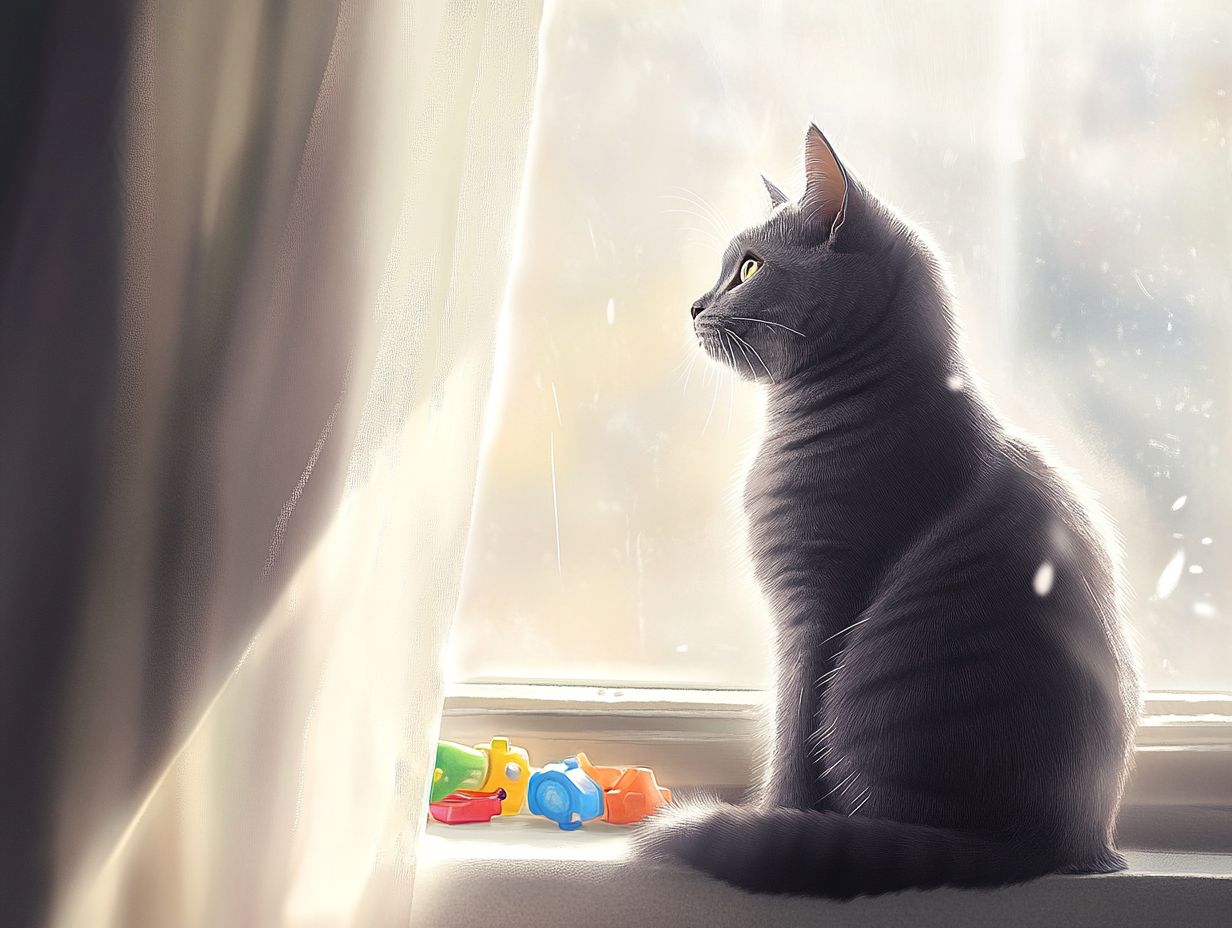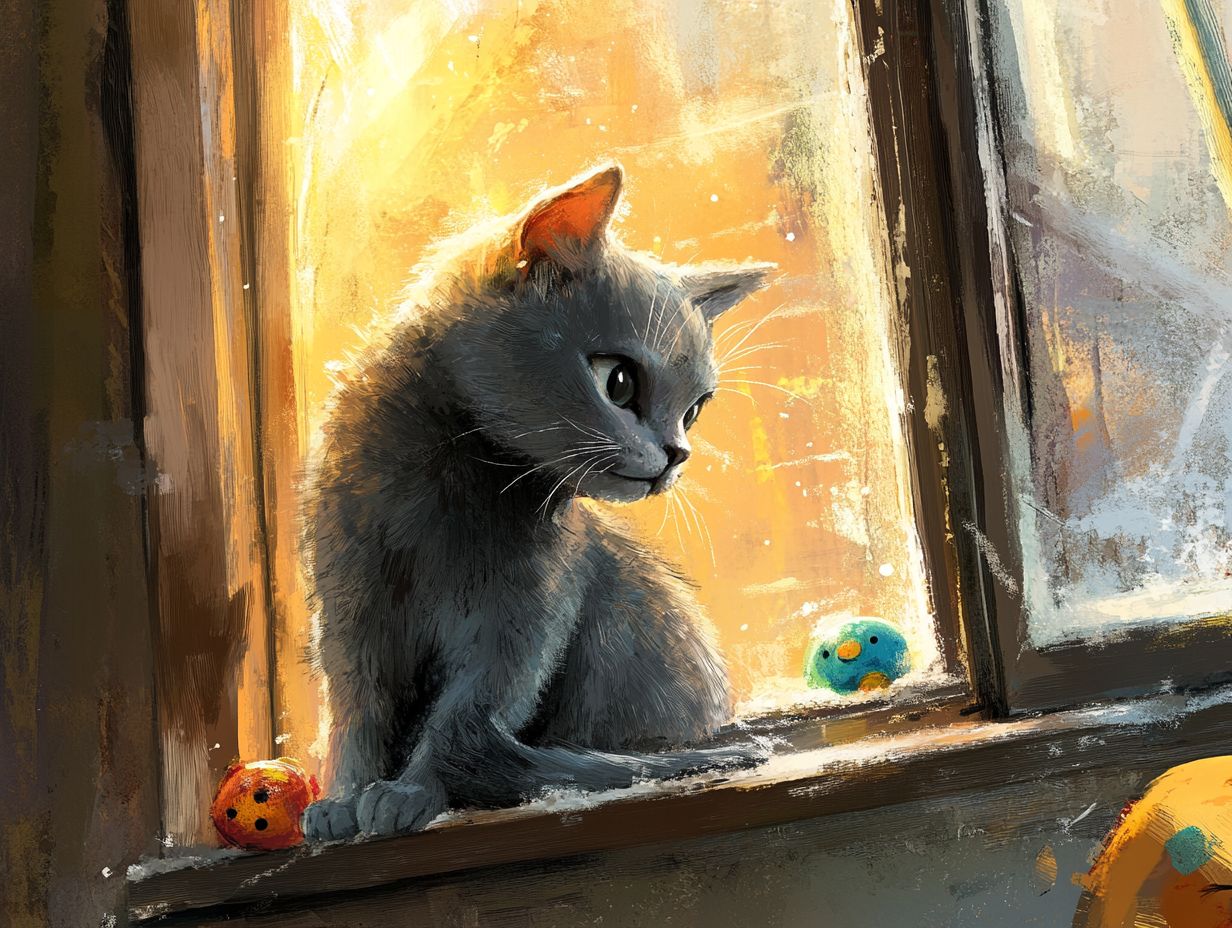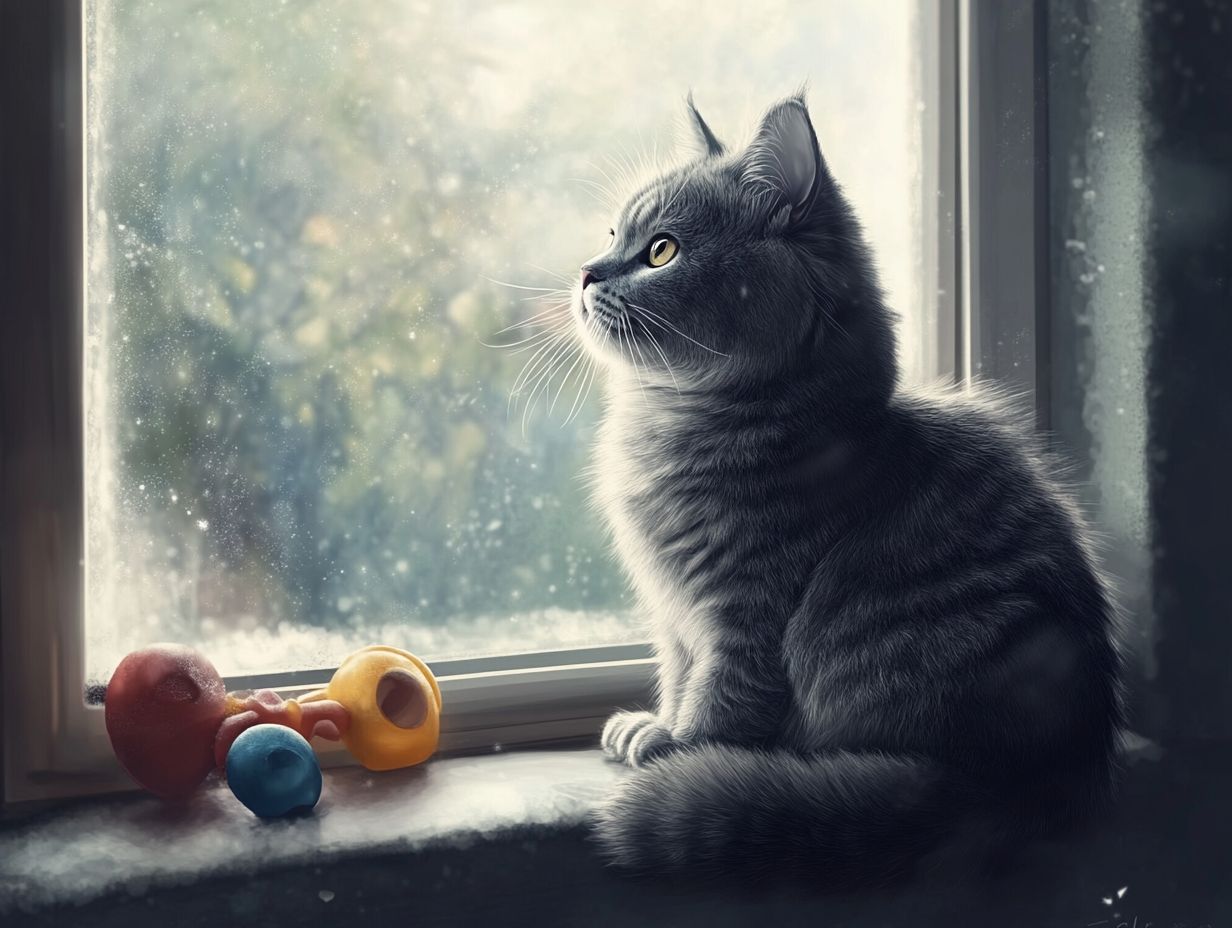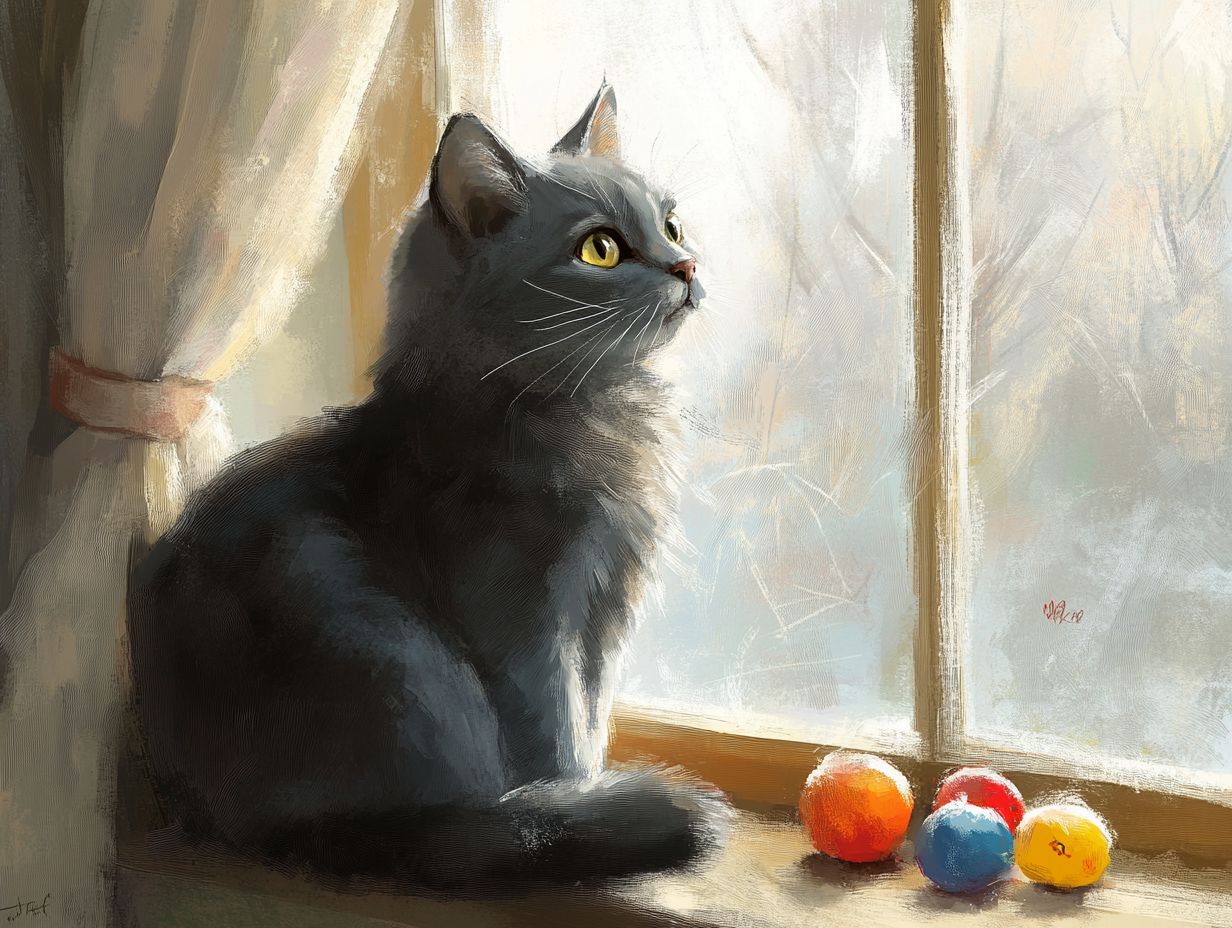Grief isn’t just a human experience; our feline friends, including companion cats, can feel it too. Studies from Michigan State University, particularly the research titled Feline Emotional Responses to Loss, have highlighted this aspect of feline psychology.
If you’ve ever wondered whether cats can mourn the loss of a companion or struggle with changes in their environment, you’re not alone. Research from Oakland University, led by Jennifer Vonk and Brittany Greene, in their study The Emotional Lives of Cats, explores these emotional responses. Factors such as the cat’s environment, prior experiences, and individual personality traits significantly influence their grieving process.
This article explores the signs and behaviors that indicate grief in cats, the various causes of their sorrow, and how you can help your pet through these tough times with advice from organizations like the Blue Cross and the American Society for the Prevention of Cruelty to Animals.
Discover the depths of feline emotions and learn how to support a grieving cat on their journey to healing, with insights from the Feline Advisory Board and the Pet Bereavement Support Service.
Key Takeaways:

What Is Grief?
Grief is a complex psychological and behavioral response to loss, encompassing a wide range of emotional reactions such as sadness, anger, confusion, and loneliness. It is a normal response, whether the loss involves the death of a loved one or a cherished pet.
Grief is a natural aspect of the human experience, and the process of mourning differs for each individual. This is why understanding the various stages of grief is essential. The stages typically include denial, anger, bargaining, depression, and acceptance.
Do Cats Experience Grief?
Yes, cats do experience grief, and their reactions to loss can resemble those of humans. Research indicates that when a cat dies or is removed from a household, the other cats in the home may exhibit signs of grief through various behavioral changes.
These responses can include alterations in appetite, sleep patterns, vocalizations, and personality. Such behaviors highlight the strong bond cats have with their companions and underscore the importance of providing them with the care they need to cope during difficult times.
What Are the Signs of Grief in Cats?
The signs of grief in cats can vary significantly and often manifest as behavioral changes that reflect their emotional state. Common indicators of grief in cats, which may suggest feelings of sadness and distress, include:
- Decreased appetite
- Lethargy
- Increased vocalization
- Withdrawal from social interactions
These signs are crucial for pet owners to recognize, as they highlight the cat’s need for emotional support and companionship during a challenging time. For instance, if a cat refuses to eat food it usually enjoys, this can be a concerning sign of distress.
Recognizing these signs underscores the profound impact of loss on a cat’s mental well-being and the importance of providing gentle care and comfort from their owners.
How Do Cats Grieve?
Cats express grief in distinct ways, heavily influenced by their circumstances, relationships, and emotional attachments. During this grieving process, a cat may exhibit behaviors such as searching for their lost companion, vocalizing more than usual, or demonstrating increased affection toward their owners.
Each cat’s grieving process is unique and often reflects its individual personality and emotional needs. For instance, kittens, adult cats, and senior cats may exhibit grief differently due to their developmental stages and social experiences.
What Can Cause Grief in Cats?
Cats can experience grief for various reasons, each of which can negatively impact their emotional health and behavior. Factors such as breed and genetics can influence a cat’s response to grief. For example, breeds like Siamese and Ragdoll are often noted for their strong social behaviors, which can make them more attuned to changes in their environment.
Understanding the human-cat bond is essential, as strong relationships can significantly influence a cat’s emotional well-being and coping mechanisms during grief. Myth-busting common misconceptions, such as the belief that “cats are indifferent to loss,” helps to clarify their emotional depth.
Signs of stress and anxiety in grieving cats can also include hiding, pacing, or excessive grooming. It’s important to mitigate these feelings through positive reinforcement, like offering treats or engaging them in play.
When to Seek Professional Help
It’s crucial to recognize when a cat’s grief may be severe or prolonged. Seeking professional help from veterinarians or animal behaviorists can provide guidance, especially if the signs of grief manifest as severe behavioral changes.
Consider proactive strategies to support a cat through potential grief before it escalates. Ruling out medical issues that may mimic or exacerbate signs of grief is also essential.
For practical applications, pet owners can follow step-by-step routines for comforting a grieving cat, such as maintaining a calm environment and slowly reintroducing familiar routines and companions.
Addressing ethical considerations, particularly regarding decisions related to euthanasia or rehoming, should be approached with compassion and sensitivity, ensuring the best interest of the pet is prioritized.
Common causes of grief in cats include the death of a companion—whether another animal or a human—moving to a new home, the arrival of new family members (either human or pet), and changes in routine. Understanding these aspects enables owners to provide better care. For more on feline grief, check out studies from the Journal of Veterinary Behavior and the ASPCA.
The loss of familiar surroundings and routines can lead to distress and feelings of loneliness in a grieving cat. Awareness of these changes is crucial for providing the necessary care and comfort. Owners should consider both physical health and emotional well-being when assessing a grieving cat.
Loss of a Companion

The loss of a companion is one of the most profound causes of grief in cats, as they often form strong emotional bonds with other animals or people in their household. This emotional absence can lead to significant behavioral changes, including increased vocalization, alterations in eating habits, and social withdrawal. It is crucial for owners to recognize this aspect of grieving, as it underscores the need for support during this challenging time. Different breeds may also exhibit unique responses to grief, influenced by their genetics and previous experiences.
The effects of grief are not merely temporary; the emotional impact can linger for weeks or even months as the cat adjusts to a world that feels empty. Cats thrive on routine, and a routine shared with a beloved companion creates a sense of safety and comfort. The absence of this routine can result in anxiety and confusion. Some cats may even regress in their litter box behaviors, signaling their distress.
Recognizing these signs of grief is important, as they highlight the vital role companionship plays in a cat’s life. Providing simple support, such as maintaining shared routines or offering extra affection, can help them through their grieving process. Additionally, using positive reinforcement techniques can enhance the effectiveness of the support provided, avoiding negative reinforcement that could exacerbate their distress.
Change in Environment
Changes in a cat’s environment can significantly affect their emotional state and may even lead to feelings of grief. Moving to a new home, introducing a new pet, or altering the household routine can cause distress and anxiety for cats, who are creatures of habit and thrive in stable environments. Understanding the impact of these changes enables cat owners to better support their pets as they adjust to and process their emotional responses. Incorporating environmental enrichment, like interactive toys or scratching posts, can alleviate stress during these times.
When faced with environmental changes, it is common for cats to exhibit behavioral shifts, such as increased hiding, changes in appetite, or even aggression. The stress of new surroundings or a new companion can make a cat feel unsafe and insecure.
Cat owners can facilitate a smoother transition by maintaining a consistent feeding schedule, providing safe spaces, and offering extra love and attention. By recognizing how their pets are emotionally affected by these changes, owners can create a supportive environment that allows their cats the time they need to adapt to new circumstances.
Loss of Routine or Familiarity
Routine or changes in familiarity can be a significant source of grief for cats, as they are creatures of habit that thrive in stable environments. Alterations in daily activities—such as feeding times, play sessions, or sleeping arrangements—often lead to confusion and emotional distress, impacting a cat’s behavior and mental state.
For instance, a cat accustomed to playing with its owner every night upon the owner’s return from work may appear disoriented and withdrawn when the owner begins a new job outside the home. Owners who observe such behavioral changes may not recognize that they stem from a shift in routine, and they might inadvertently contribute to the cat’s discomfort by failing to provide active support and reassurance during the transition to a new normal.
When a cat’s schedule changes, the emotional bond it shares with its owner can become strained, as the feline may struggle to understand the reasons behind the interruptions. This gap in communication can lead to feelings of isolation and heightened anxiety.
If not addressed properly, this situation can even result in a breakdown of the human-animal bond, causing the cat to become increasingly withdrawn and aloof. Since routine offers predictability and structure, cats experiencing disruptions may exhibit heightened emotional responses, such as excessive vocalization, hiding, or even aggression. Maintaining a consistent routine is one of the most important ways to help these sensitive animals cope with their feelings of loss and uncertainty.
How Can You Help a Grieving Cat?
To help a grieving cat, it is important to recognize the signs of grief and provide the emotional support they need during this difficult time. The human’s behavior can greatly affect a cat’s emotional state.
Some effective ways to assist a grieving cat include:
- Identifying and understanding the signs of grief.
- Incorporating environmental enrichment to stimulate mental health.
- Using positive reinforcement techniques to encourage desired behaviors.
- Maintaining routines to create a sense of stability.
- Offering safe spaces and extra affection.
- Considering professional help when behavioral changes persist.
- Monitoring health to rule out medical issues that may manifest as behavioral changes.
- Providing calming aids, like pheromone diffusers or soothing music.
- Engaging in ongoing education about feline behavior and emotional health.
- Providing extra love and affection
- Maintaining a consistent routine
- Allowing them to grieve at their own pace
- Offering companionship—whether from humans or by gradually introducing a new pet
Helping a grieving cat adjust to their new normal can reduce feelings of melancholy and impulsiveness.
Provide Comfort and Reassurance
Comforting and reassuring a grieving cat is essential for easing their emotional discomfort and helping them feel safe. Simple actions, such as spending time beside them, gently stroking them, and speaking softly, can significantly enhance their sense of safety and companionship.
Creating an inviting environment filled with familiar objects can help alleviate feelings of sadness and loneliness during this difficult time. Maintaining a consistent daily routine provides a crucial sense of normalcy, which is vital for their emotional well-being. This approach, supported by studies such as those from Oakland University (https://www.oakland.edu) and the American Society for the Prevention of Cruelty to Animals (https://www.aspca.org), emphasizes the importance of routine in reducing stress and fostering emotional balance.
Engaging in interactive play can serve as a positive distraction, allowing them to express their natural instincts while strengthening the bond with their human companion. According to Pet Bereavement Support Service (https://www.petbereavement.com), offering treats or favorite toys can also reinforce feelings of happiness and comfort, promoting psychological well-being and companionship.
Most importantly, being patient and observant of their individual needs will ensure they receive the emotional support necessary to process their grief and gradually return to their playful selves. This involves understanding their behaviors and providing care to facilitate adjustment.
Keep a Consistent Routine
Establishing a routine is crucial for grieving cats, as it helps them adjust to their new emotional state and find stability. Regular feeding times, play sessions, and sleep schedules provide them with familiar anchors, making it easier for them to cope with their loss and navigate their emotional journey.
This structure can mitigate some behaviors associated with grief. Maintaining a daily rhythm is essential for their emotional well-being, as it fosters a sense of safety in their environment. Research from Jennifer Vonk (https://www.jennifervonk.com) and Brittany Greene highlights the significance of consistency in reducing distress and encouraging positive actions.
When routines are followed, cats are likely to experience less confusion and greater comfort as they search for predictable moments throughout the day. Engaging in familiar activities creates a supportive emotional network and encourages healthy behaviors, facilitating their healing process.
By observing these routines, cat guardians can better understand their pets’ emotional needs during this challenging time, fostering bonding and healing through stable and loving moments. The Society for Companion Animal Studies (https://www.scas.org) advises on the importance of maintaining relationships and providing comfort to support the grieving process.
Signs of Stress and Anxiety in Cats
Recognizing signs of stress and anxiety is crucial when caring for a grieving cat. Common indicators include:
- Excessive hiding
- Changes in appetite
- Increased vocalization
- Changes in grooming habits
- Aggression or withdrawal
Understanding feline body language can help guardians better support their grieving pets. Consider using infographics or images to visually illustrate these cues.
Introduce New Companions Slowly

Introducing new companions to a grieving cat should be done gradually, as quick introductions can be stressful and emotionally overwhelming for the cat. A gradual approach allows the grieving cat to adjust to the presence of a new pet while prioritizing its emotional needs. This method encourages more positive interactions between the animals and strengthens their bond of companionship and support, aligning with guidelines from the Blue Cross (https://www.bluecross.org.uk).
To begin the introduction process, it is helpful to create separate spaces for both the grieving cat and the new companion. This arrangement provides each pet with a safe and secure area, while also allowing them to become familiar with one another through scent and sound. The Feline Advisory Board (https://www.felineadvisoryboard.com) suggests that such setups reduce stress and facilitate understanding between new companions.
Positive reinforcement should be employed frequently during these introductions, ensuring that the new companion is associated with pleasant experiences, such as treats and affection.
Environmental Enrichment Activities
Creating a stimulating environment is essential for a grieving cat. Consider activities such as:
- Using puzzle feeders to promote mental engagement
- Incorporating interactive toys that challenge their instincts
- Providing vertical spaces like cat trees for climbing
- Establishing hiding spots for safe retreats
When to Seek Professional Help
If a grieving cat exhibits prolonged signs of distress or changes in behavior, it might be time to seek professional help. Signs to look for include:
- Persistent lethargy
- Increased aggression
- Severe weight loss or gain
- Inability to engage in normal activities
Consulting with a veterinarian or animal behaviorist can provide tailored advice and support.
Troubleshooting Common Behavioral Issues
Common behavioral issues during the grieving process may include:
- Inappropriate elimination—often a sign of stress. Solutions may include providing additional litter boxes and maintaining cleanliness.
- Excessive vocalization—this can indicate anxiety. Providing more playtime and interaction may help.
- Loss of appetite—ensure access to favorites and monitor health closely to prevent serious issues.
Continuously monitoring the grieving cat’s behavior will help assess whether adjustments to the introduction process are necessary, allowing it to adapt at its own pace. Paying careful attention to the cat’s emotional responses fosters an environment where both pets feel secure, ultimately strengthening their companionship.
When Should You Seek Professional Help for a Grieving Cat?
Recognizing when to seek professional help for a grieving cat is crucial for ensuring their emotional and physical well-being. If a cat shows prolonged signs of distress, such as significant changes in appetite, lethargy, or withdrawal from social activities that last beyond a reasonable timeframe, it may be necessary to consult a veterinary professional or animal behaviorist. The Pet Loss Support network offers advice on identifying signs that require expert intervention, and you can read more about this in the study referenced in the NPR article on cat grief.
For instance, changes in sleeping patterns or sudden aggression could indicate deeper emotional distress. Frequent yowling or other vocalizations might signal a need for increased attention, while anxiety-related behaviors like excessive grooming or inappropriate litter box usage should be monitored for appropriate responses. Understanding feline behavior is key; different age groups—kittens, adults, and seniors—may exhibit varying responses to loss due to their developmental stages.
Consulting a professional can assist caregivers in understanding the unique signals their grieving cat is exhibiting. Engaging with a veterinarian may also lead to recommendations for behavioral therapies or medications that can alleviate anxiety related to loss.
Being aware of these signs early on can facilitate more effective coping and emotional recovery in grieving felines.
Can Cats Grieve for Humans?
Cats can experience emotional distress when their human companions are no longer present, demonstrating their ability to form strong emotional bonds. When a beloved owner passes away, cats may exhibit behavioral changes that are reflective of their unique emotional states. These reactions highlight the intricate ways cats process loss within their own cognitive frameworks.
The emotional distress they experience may manifest in changes in behavior, eating habits, and overall disposition, emphasizing the profound bond between cats and their humans.
What Are the Signs of Grief in Cats for Humans?
Cats exhibiting distress from the loss of a human companion display a range of emotional and behavioral changes. Common indicators include increased vocalization, changes in sleep patterns, and altered eating habits, which signal that the cat is processing its feelings. It is crucial for caregivers to recognize these signs as they underscore the cat’s need for care and support during this challenging period.
In addition to these apparent signs, subtler behaviors may emerge, revealing the depth of the feline’s distress. For instance, a cat may become withdrawn, refusing to engage in activities it once enjoyed. Some cats might seek comfort in familiar environments, curling up in spots that remind them of their deceased companion. It is also common for them to become anxious, exhibiting behaviors such as excessive grooming or pacing as they cope with their emotional state.
How Can You Help a Cat Grieve for a Human?
Helping a cat through its grief involves recognizing its emotional state and providing necessary support to alleviate distress. Consistent companionship, interactive play, and maintaining regular routines are key elements that can assist a cat during the grieving process. Incorporating techniques from Applied Animal Behaviour Science can further enhance this support.
Offering gentle reassurance and extra affection can help the cat process feelings of grief and create an environment conducive to emotional recovery. Each cat has its own unique way of coping; some may become more affectionate and seek close contact, while others may prefer solitude. Understanding these changes is crucial for effective emotional support.
It is beneficial to provide the cat with a separate safe space to retreat to when feeling overwhelmed. Additionally, introducing environmental enrichment strategies such as new toys or exploration spaces can be soothing. Regular veterinary visits are essential, as some cats may lose their appetite or exhibit other behavioral changes during this time.
Recognizing Body Language and Signs of Stress
Understanding feline body language is essential in recognizing signs of distress during grief. Look for cues such as flattened ears, tail position, and whisker positioning to assess how your cat is feeling. Visual aids or diagrams can be valuable tools for learning these signals.
Observing signs of stress and anxiety in cats is critical during this time. Specific behaviors to monitor include hiding, loss of appetite, and increased vocalization, all of which may relate to their emotional state.
Behavior Modification Techniques
Implementing behavior modification techniques can provide additional support for grieving cats. A patient and understanding approach is essential, as positive reinforcement can encourage desirable behaviors while avoiding punishment, which may exacerbate stress and anxiety.
It is important to clearly outline when to seek professional help. Veterinary professionals and animal behaviorists can evaluate the cat’s condition, and caregivers can expect consultations to focus on tailored strategies for emotional recovery.
For ongoing learning about feline behavior and emotional health, consider exploring resources such as books, articles, or websites dedicated to cat care. This knowledge can empower caregivers to provide the best support for their grieving pets.
By observing the cat’s reactions and making small adjustments to their environment, caregivers can play a crucial role in supporting their emotional health during this difficult period. Insights from peer-reviewed studies on feline psychology and bereavement, such as those published in the Journal of Feline Medicine and Surgery, emphasize the importance of tailored care.
Frequently Asked Questions
Do Cats Grieve?

Yes, cats can experience grief in response to the loss of a companion or owner.
How do cats show their grief?
Cats may show their grief through changes in behavior, such as loss of appetite, increased vocalization, or withdrawal from social interactions. Individual variation, such as breed, genetics, and previous experiences, can influence these behaviors.
Can cats grieve the loss of another pet?
Yes, cats can grieve the loss of another pet in the household, especially if they had a close bond with the deceased pet.
Do cats understand death and loss?
While cats may not have the same level of understanding as humans, they can sense changes in their environment and the absence of a companion or owner.
How can I help my grieving cat?
Provide your cat with extra love and attention, maintain a routine, and consider getting a new companion or playmate for your cat. Additionally, incorporate environmental enrichment and safe activity ideas, such as interactive toys and climbing structures, to stimulate your cat’s mind and reduce stress.
How long does cat grief last?
The grieving process for cats can vary, but it typically lasts for several weeks to a few months. If your cat’s grief seems prolonged or severe, consult a veterinarian for advice.
Understanding Cat Grief Across Developmental Stages
Grieving behaviors can manifest differently in various developmental stages:
- Kittens: May exhibit more clingy behavior and seek extra comfort.
- Adults: Can show changes in appetite and social engagement.
- Seniors: Might display confusion and increased vocalization.
Maintaining a Stable Environment
In multi-cat households, it is crucial to maintain a stable environment, especially when one cat is grieving. Managing introductions and interactions can help reduce stress for both grieving and non-grieving cats.
Problem Behavior Analysis
Understanding potential symptoms of distress in grieving cats is essential. Symptoms may include litter box issues, aggression, or excessive grooming. It’s important to analyze these behaviors and consider underlying causes beyond grief.
Positive Reinforcement Techniques
When helping cats cope with grief, it’s vital to avoid punishment, as it can exacerbate their distress. Instead, focus on positive reinforcement techniques to encourage desired behaviors and provide comfort.
Ongoing Learning
Encourage caregivers to deepen their understanding of feline behavior and emotional health by exploring reputable resources such as books and websites dedicated to feline psychology.